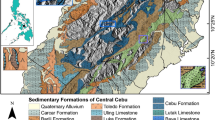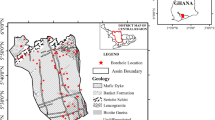Abstract
Lineament density maps can be used for the quantitative evaluation of relationships between lineaments and the occurrence of groundwater. This paper reports the usefulness of the representative elementary area (REA) concept for lineament analysis. This concept refers to the area of the unit circle needed to calculate the lineament density factors distributed within the circle: length, counts and cross-points counts. The circle is a unit circle where one calculates the sum of the lineament length, lineament counts and the number of cross-points within it. The REA is needed to obtain the best representative lineament and ground-water well yield or other groundwater characteristics. A lineament map for the Yongsangang-Seomjingang watershed of Korea was used for demonstrating the concept. It is shown that the REA concept can be efficiently applied to lineament density analysis and mapping. In the demonstration case, the lineament densities are inversely proportional to the size of the REA and the REA can be calculated with this inversely linear regression model. If the average lineament density values for the whole study area are known, the most accurate density maps can be drawn using the REAs obtained from each linear regression model.
Similar content being viewed by others

References
Bear, J., 1972, Dynamics of fluids in porous media. Elsevier, New York, 764 p.
Caponera, F., 1989, Remote sensing applications to water resources: remote sensing image interpretation for ground water surveying. Food and Agriculture Organization of the United Nations, Rome, 393 p.
Casas, A.M., Cortes, A.L., Maestro, A., Soriano, M.A., Riaguas, A. and Bernal, J., 2000, LINDENS: a program for lineament length and density analysis. Computer Geosciences, 26, 1011–1022.
Costa, R.D. and Starkey, J., 2001, Photolin: a program to identify and analyze linear structures in aerial photographs, satellite images and maps. Computer Geosciences, 27, 527–534.
ESRI (Environmental Systems Research Institute, Inc.), 1996, Using Avenue: customization and application development for Arc-View GIS. ESRI, Redlands, CA, 340 p.
Hazzanizadeh, M. and Gray, W.G., 1979, General averaging equations for multi-phase systems: 1. Averaging procedure. Adv. Water Res., 2, 131–144.
Hobbs, B.E., Means, W.D. and Williams, P.F., 1976, An outline of structural geology. John Wiley & Sons, New York, p. 571.
Karnieli, A., Meisels, A., Fisher, L. and Arkin, Y., 1996, Automatic extraction and evaluation of geological linear features from digital remote sensing data using a Hough transform. Photogrammetric Engrg Remote Sensing, 62, 525–531.
Kim, C, 1995, GIS application to groundwater study. Kor. Soc. J. Civil Engineers, 15, 149–156.
Kim, G.B., 1999, Guideline for construction and management of hydrogeological map in Korea. Journal of Korean Water Research, 32, 82–95.
Kim, G.B., Cho, M.J. and Lee, J.Y., 2000, A study on the illustration of hydrogeological map using Arc View and AvenueTM script. In Proceedings of 2000 Fall Meeting of Korean Society of Soil and Groundwater Environment (Abstract). Pohang, November, 17–18, p. 31–35.
Koike, K., Nagano, S. and Ohmi, M., 1995, Lineament analysis of satellite images using a segment tracing algorithm (STA). Computer Geosciences, 21, 1091–1104.
KOWACO (Korea Water Resources Corporation), 1998, Hydrogeological survey of Yongsangang-Seomjingang watersheds.
Lattman, L.H. and Parizek, R.R., 1964, Relationship between fracture traces and the occurrence of ground water in carbonate rocks. Journal of Hydrology, 2, 73–91.
Mabee, S.B., Hardcastle, K.C. and Wise, D.U., 1994, A method of collecting and analyzing lineaments for regional-scale fractured-bedrock aquifer studies. Ground Water, 32, 884–894.
Magowe, M. and Carr, J.R., 1999, Relationship between lineaments and ground water occurrence in western Botswana. Ground Water, 37, 282–286.
Mah, A., Taylor, G.R., Lennox, P. and Ballia, L., 1995, Lineament analysis of Landsat thematic mapper images, Northern Territory, Australia. Photogrammetric Engrg Remote Sensing, 61, 761–773.
O'Leary, D.W., Freidman, J.D. and Pohn, H.A., 1976, Lineaments, linear, lineation-some proposed new standards for old terms. Geological Society of America Bulletin, 87, 1463–1469.
Park, Y.J., Lee, K.K. and Kim, J.M., 2000, Effects of highly permeable geological discontinuities upon groundwater productivity and well yield. Mathematical Geology, 32, 605–618.
Razavi, A.H., 1995, Arc View developer's guide, OnWord Press, New York, 274 p.
Saraf, A.K., 2001, Drainage/lineament/roads density analyst extension (version 1.0). ESRI, Redlands, CA.
Wood, E.F., Sivapalan, M., Beven, K. and Band, L., 1988, Effects of spatial variability and scale with implications to hydrologic modeling. Journal of Hydrology, 102, 29–47.
Yin, Z.Y. and Brook, G.A., 1992, The topographic approach to locating high-yield wells in crystalline rocks: does it work? Ground Water, 30, 96–102.
Author information
Authors and Affiliations
Corresponding author
Rights and permissions
About this article
Cite this article
Kim, GB., Lee, JY. & Lee, KK. Application of representative elementary area (REA) to lineament density analysis for groundwater implications. Geosci J 8, 27–42 (2004). https://doi.org/10.1007/BF02910276
Received:
Accepted:
Issue Date:
DOI: https://doi.org/10.1007/BF02910276



